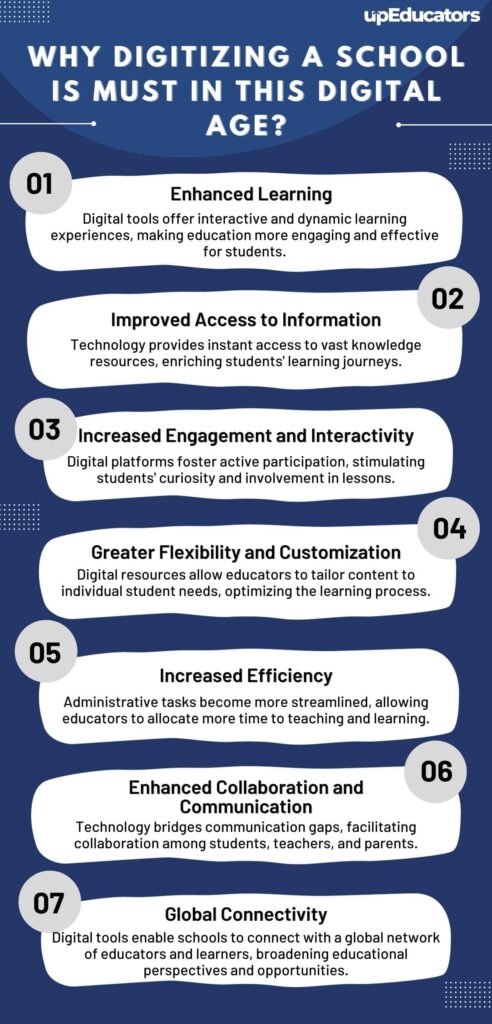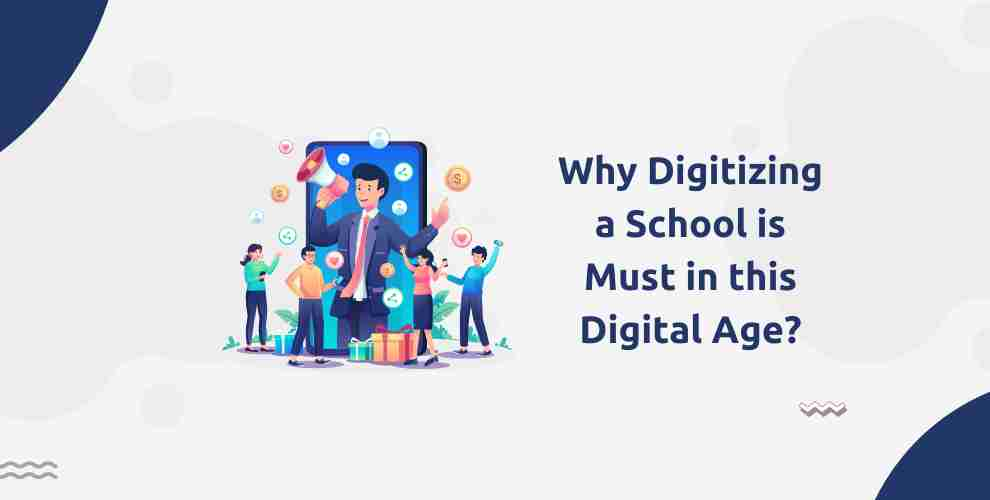A private school in Delhi embraced digital tools and technologies to enhance its traditional classroom model and cater to the diverse learning needs of its students. They equipped classrooms with interactive whiteboards, projectors, and tablets, and provided teachers with training to effectively integrate multimedia resources into their lessons. The school also implemented a one-to-one device program, giving each student access to a laptop or tablet for assignments and learning resources. They adopted a learning management system (LMS) for communication, assignment submission, grading, and access to digital resources like online textbooks and interactive study materials.

The adoption of digital tools had a positive impact on student learning outcomes. Students became more engaged, and teachers found it easier to provide personalized learning experiences and targeted feedback. The use of digital tools also improved efficiency by simplifying administrative tasks like grading and communication. This freed up teachers’ time to focus on instruction and student support, promoting a more effective learning environment. Overall, the school’s efforts to incorporate digital technologies resulted in enhanced student engagement, personalized learning experiences, and increased efficiency in administrative tasks.
Digitizing a school is not a luxury but a necessity in this digital age. More schools are moving towards digitization as it has proven to have many positive effects on the overall learning outcome.
upEducators has trained thousands of educators and principals in learning digital skills to improve teaching and learning. After talking to these educators, we found out what benefits and improvements these educators and principals saw in their teaching and in their schools. Let us look at some of the most common benefits teachers and principals experience after adopting digital tools and technologies in the teaching-learning process.
Enhanced learning
Digitizing the school campus and classroom provides students with access to rich digital resources. Digital resources help in overcoming different barriers to learning. For instance, it makes learning more accessible by providing instant resources. A digital school with smart learning tools will always be far ahead in improving learning than a traditional school that is reluctant to use technology and digital tools.
Improved access to information
Digitizing a school can greatly improve access to information for students and teachers. By digitizing textbooks, videos, and other educational materials, students can access them at any time and from anywhere, providing them with flexibility in their learning. Digitized materials can also be easily updated and revised, ensuring that students always have access to the latest and most accurate information
Increased engagement and interactivity
By digitizing educational materials, teachers can incorporate multimedia resources, interactive activities, and simulations that can make learning more engaging and fun. This can help students to be more motivated and enthusiastic about their studies, leading to improved learning outcomes.
Greater flexibility and customization
Digitizing a school provides greater flexibility and customisation in learning for both students and teachers. By digitizing educational materials, students can access learning resources from anywhere, at any time, and on any device. This allows for greater flexibility in scheduling and allows students to learn at their own pace.
Additionally, digital tools can offer personalized learning experiences, allowing teachers to track students’ progress, offer tailored feedback, and adjust teaching methods to meet the needs of individual students. This can help students to achieve better learning outcomes and reach their full potential.
Increased efficiency
Digitizing a school can lead to increased efficiency in many aspects of the educational process. By digitising educational materials, teachers can save time and effort by not having to prepare physical materials for each lesson. They can also easily update and revise digital resources, ensuring that the most current and accurate information is always available.
Moreover, digital tools can automate administrative tasks, such as grading and attendance tracking, freeing up teachers’ time to focus on instruction and student support.
Enhanced collaboration and communication
Digital tools can enable collaborative learning experiences. Students can use online tools to work together on projects, share knowledge and ideas, and develop important social and communication skills. This can enhance their engagement with the learning process and foster a sense of community in the classroom.
Moreover, digitizing a school can improve communication between teachers, students, and parents. Online platforms and tools can enable teachers to provide regular updates on students’ progress, share resources with parents, and communicate with students outside of the classroom. This can help to build stronger relationships between teachers, students, and parents and create a more supportive and engaging learning environment.
Global Connectivity
Digitizing a school provides global connectivity, allowing students and teachers to connect and collaborate with peers and experts from around the world. Digital tools and resources can enable students to participate in online courses and programs, engage in virtual exchanges with students from other countries, and communicate with experts and professionals in various fields.
Moreover, digitizing a school can expose students to a wider range of perspectives and ideas, helping them to develop a global perspective and become more culturally aware. Through online platforms and tools, students can learn about different cultures, customs, and languages, and interact with peers from diverse backgrounds. This can help to promote cross-cultural understanding and empathy and prepare students for success in an increasingly globalized world.
Digital tools can also enable teachers to access and share resources and ideas with educators from around the world. Through online communities and networks, teachers can collaborate with colleagues to develop new teaching strategies, share best practices, and stay up-to-date on the latest trends and research in education.
In today’s digital age, it is essential for schools to digitize their operations and teaching methods to keep up with the changing times and prepare students for the future. Digitizing a school offers numerous benefits, including enhanced learning outcomes, increased engagement and interactivity, greater flexibility and customization in learning, improved access to information, and global connectivity. By integrating digital tools and technologies into the classroom, teachers can create more personalized and engaging learning experiences for their students, making learning more effective and efficient.
Author: This article is written by Samiya Rashid for upEducators blog.




